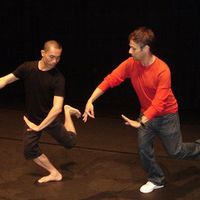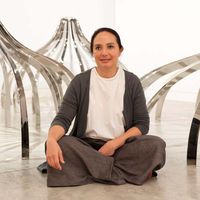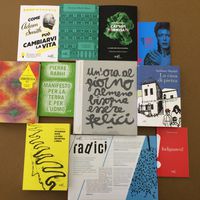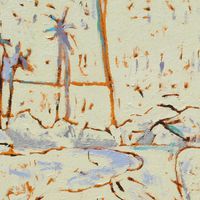Thanom Chapakdee: Decentralising Thai Contemporary Art

This month, culture360 contributor Naima Morelli interviews Thai curator Thanom Chapakdee, founder of Khon Kaen Manifesto and a critical voice in the contemporary art landscape of Thailand.
2018 marked the first year that Thailand held its first, concurrent Biennales, in Bangkok (The Bangkok Art Biennale) and Krabi (The Thailand Biennale). While the enhanced cultural offering was groundbreaking for many, for others it has however been disappointing to see the same old familiar names in the art system.
Increasing diversity and variety over the contemporary art spectrum has been the core mission of Thanom Chapakdee, one of Thailand’s most respected and feared art critics – as well as an artist himself.
It was also in 2018, the visionary curator started his bi-annual Khon Kaen Manifesto. The first edition of this atypical festival gathered artists from Isaan region of Thailand and across the country’s edges. The art was bold, subversive, radical, and honest. It made local and international observers question society, politics and even historical narratives.
Manifesto was different in the sense that the contributing artists were peripheral to Thailand’s art scene, and to society at large. This was Thanom’s precise plan to de-centralize the Thai contemporary art scene, creating a breathing space for the overlooked practices in the country.
Indeed, for the curator, the main problem in the scene is a widespread confusion and division: “If you look at the art scene in Thailand, you can see a reflection of the chaos of Thai society. Each artist sets his own rules. In terms of market, prices don't make any sense. Everyone is creating their own niche market, resulting in Thai art being much more expensive than other art from the region. That damages everyone.“
Naima Morelli (NM): Can you describe the dynamics of the market in Thailand in more detail?
Thanom Chapakdee (TC): Artists don't care about galleries, dealers, curators or institutions, they sell directly to collectors. I feel this is hindering the growth of the system. Everyone is doing their own thing in a very self-contained way and there is not much communication among the different art circles. This makes art critique extremely difficult in this scenario. Criticism can potentially destroy an already fragile allegiance between artists. Consequentially, the art itself becomes weak. Even to preserve an important space such as the Bangkok Art and Culture Center (BACC), has proved difficult in the last few years. Given the structure Thai society, the art system is doomed. For me, society needs to change first. Then and only then, the art scene would evolve too.

Thai curator Thanom Chapakdee, founder of Khon Kaen Manifesto
NM: Do different generations of artists have different attitudes towards the art system and the community?
TC: During '90s and early 2000, we could see artist groups trying to organize underground movements. The thing is there was not really a strong sense of ideology of an art resistance. We just joined in for the pleasure of doing activities and exhibiting together in the public arena. Deep down no one was really talking about how we could go against mainstream culture or what was happening politically.
NM: Why did that happen in your opinion?
TC: The first reason is because of the aforementioned fear that if we would have started being too critical, the group would have split. So we bonded around the spirit of “Thainess“ to keep everyone together. Also, everybody was so new to the idea of movement, and we just tried to preserve what we had built. And then of course, there was a lack of funding to keep it all going.
However, when the political climate grew more and more tense between right wing and left wing, yellow shirts and red shirts, artists started taking sides and the whole scene split into two. The only politics criticism was very superficial and general in nature, targeting capitalism. However, artists were de facto living in a capitalist system. It was very disappointing and even hypocrite in a way.
NM: In your writing you often talk about Buddho-centrism and how this influences the attitude of artists. Can you please explain us what it means?
TC: When you stay closely to the centres of Thainess, you can't help but be influenced. This idea of Buddho-centrism started from the '30s and developed in the '50s until the '90s. The state used art and culture as a tool to manipulate people in Thailand. The idea of Buddhism, art, state and monarchy became one. They were used to promote the idea of Thainess and Thai contemporary art. In the '50s it became prominent because there was an interest in defending ourselves against socialism.

NM: In the scenario are you completely nihilist or do you see hope and a solution somewehere?
TC: Working as a curator and art critic in Thailand is quite frustrating. You don't have the freedom to write your views on newspapers. In order to be free, I turned to community work as an art activist, on a small scale. I learned that more than writing, the best way to convey your thoughs in Thailand is to demonstrate them through action. That's way more powerful. I tried to escape from the center and went outside, to start anew and fresh. That's where the idea for the festival Manifesto comes from. This was based on participatory perspectives and we had artists developing art on the field, with the local community.
NM: How did the organisation of Manifesto pan out in the context of the two Biennales?
TC: Last year in October, I announced to the refusés from Bangkok Art Biennale and Thailand Biennale that they were welcome to join Manifesto. And they did. The concept was to create an aesthetics of resistance; we wanted to go beyond the object. We brought in different narratives, the genius loci, socio-anthropology and cultural activities as art. The North-eastern and deep Southern provinces are usually not the places where contemporary art happen and we want to change that.
The next edition of Manifesto will be in October and November next year (2020) in Khonkaen and Ubon respectively, and in four years time (2022) I'm planning to hold it in Si Sa Ket and Surin in Thailand, and Siem Reap, Cambodia.
Naima Morelli is a journalist and arts writer researching emerging art systems. She is specialized in the Asia-Pacific region, focusing on Singaporean, Indonesian and Australian art and she is currently researching Cambodian contemporary art. Currently based in Rome and constantly on the go, she has the mission of bridging Asia and Europe through art, culture and words. Her pieces regularly appear on CoBo Social, Art Republik, culture360, Art a Part of Culture and Middle East Monitor. In the past she has written for Art Monthly Australia, ArtsHub, NY Arts, Artribune, I-Magazine Bali, The Times of Malta among others, and she has contributed texts to a number of publications and exhibitions catalogs. She is also the author of the book “Arte Contemporanea in Indonesia”, a narrative essay published in Italy. The book shows how contemporary art produced in Indonesia can’t just be labelled as “Indonesian”, while tracking the context’s influences on the art itself.
Similar content
07 Nov 2009
15 Jan 2018
from - to
02 Feb 2012 - 29 Mar 2012






